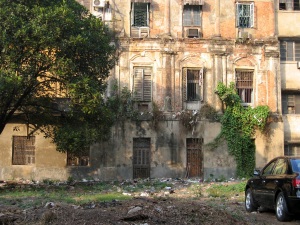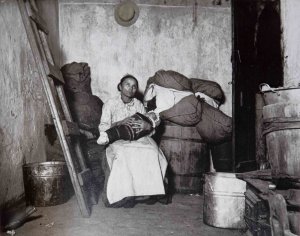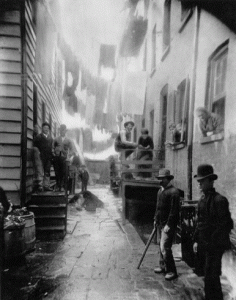In Dickens’ David Copperfield, trash is a marker of class. When David goes in search of his irrepressible old school friend Tommy Traddles, for instance, he finds a street strewn with scraps of food and broken belongings, an index of Tommy’s straightened circumstances:
I found that the street was not as desirable a one as I could have wished it to be, for the sake of Traddles. The inhabitants appeared to have a propensity to throw any little trifles they were not in want of, into the road: which not only made it rank and sloppy, but untidy too, on account of the cabbage-leaves. The refuse was not wholly vegetable either, for I myself saw a shoe, a doubled-up saucepan, a black bonnet, and an umbrella, in various stages of decomposition, as I was looking out for the number I wanted.
Dickens ascribes a certain carelessness to the inhabitants, but the real difference between this street and a more upscale one would have been a lack of servants or other resources to have the trash cleaned up and carted away.
William Rathje, who analyzed and quantified residential garbage in Tucson and elsewhere in the US, showed that, in our own time, the wealthy create more garbage than the poor. Before we can throw something out, we have to buy it, after all. And the more money we have, the more we buy, the more we throw out. The effect may be magnified by consumerism, but there’s no reason to assume the state of affairs was essentially different in Victorian England.
The association of trash and poverty is by no means unique to Dickens, although its exact inflection varies from place to place and time to time. Phrases like “trailer trash” and “a trashy neighborhood” ring just a few of the many changes on this theme.
By and large, people distance themselves from garbage if they can afford to, but they do it in different ways, developing elaborate rituals for making it invisible or, on the contrary, refusing to handle it at all. In his Confessions of an Economic Hit Man, John Perkins tells the story of how, in the 1970s, there was a lot of evident garbage in Saudi Arabia, only diminished by roving goats. A local source explained that Arabs considered themselves above handling garbage, so it was just thrown out of doors. I think perhaps in India a similar way of thinking produces such large amounts of putrescibles in the streets, in conjuction with and in immediate proximity to an intense devotion to personal cleanliness. I’d venture to guess that more per capita washing goes on in India than in any other place in the world.
In many places, the poorest of the poor live on and off garbage dumps. I assembled a brief list in a post about scavenging. Scavenging is for many practitioners an economic imperative, and the activity tends to brand them, functioning as a social shorthand for marginal status. One of Andreas Gursky’s large-scale photographs shows that it is nevertheless possible to make a life on the dump in terms clearly reminiscent of prevailing norms. The photo shows an endless stretch of open dump in Mexico City with a little dark clump near the horizon, which, upon closer inspection, turns out to be a village. An arrangement of makeshift houses is made complete by a parked VW Beetle, apparently in working order.
Agnes Varda’s gentle documentary The Gleaners and I, about scavengers in France, points to other motivations besides economic necessity. Some gleaners don’t like the general wastefulness inherent in commercial farming, by which a good part of the harvest is dumped or simply never reaped. These gleaners follow a moral impulse diametrically opposed to the dominant econonmic mores of capitalist society, but perhaps there is also a certain waywardness in their behavior. Although there’s a general preference for orchards and fields over dumpsters among Varda’s heroes, there’s a general recognition that when the harvest is truly over in the fields, there’s another treasure waiting in the trash.
Varda also finds some who are simply fascinated by garbage, including the artists who scavenge their materials and build new things out of old in a way that exploits all the meanings adhering to the new and the old identities at the same time, the pathos and the courage both at once. Varda herself is one of these, and she shows up in the movie as a subject as well as the maker. What drives Varda, specifically, is a connection between trash and the tragic irreversibility of time, the entropic imperative by which all things progress to disorder. Her hands and her hair. Her ceiling with its leak, blossoming in frightful cabbage roses. Her carefully selected heart-shaped potatoes, from the poster, which show up several months later in an extremely disordered state.
Death and the end of time are foretold in garbage, and some prefer to make war on it, not by denial, but by careful inspection and, wherever possible, delight.



